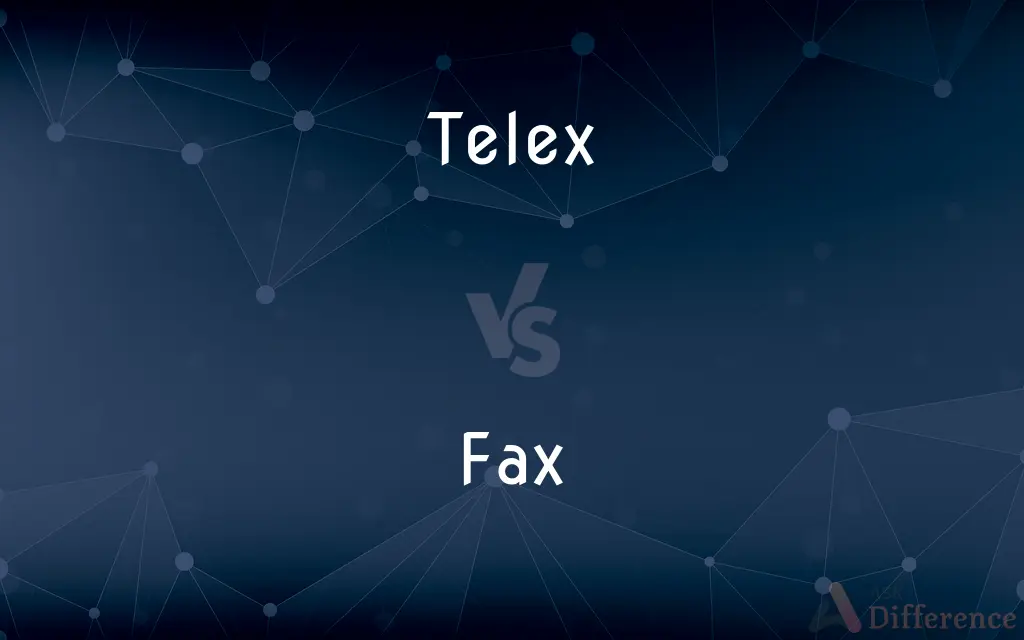Telex vs. Fax — What's the Difference?
By Tayyaba Rehman — Updated on October 20, 2023
"Telex" refers to an international communication system using teleprinters, while "Fax" is the transmission of scanned printed material over phone lines.

Difference Between Telex and Fax
Table of Contents
ADVERTISEMENT
Key Differences
"Telex" and "Fax" are both methods of sending messages over distances, but they operate on different principles. While Telex uses teleprinters connected over dedicated networks, Fax involves transmitting scanned printed material over phone lines.
When considering the era of prominence, Telex was a prominent system from the 1930s to the 1980s. In contrast, Fax, which saw its heyday in the 1980s and 1990s, allows for the transmission of graphics, texts, and even signatures, gaining favor in business settings.
The technology behind Telex involves sending text-based messages via teleprinters, whereas Fax uses modulation to translate images into sound waves, transmitting them over telephone lines, and then converting them back into images.
Telex and Fax both revolutionized communication in their times. Telex was especially vital for international business communications, offering a real-time, direct connection. Meanwhile, Fax found its niche in scenarios where documents, especially signed ones, needed quick transmission.
In the modern digital age, both Telex and Fax have seen a decline in popularity, with emails and digital messaging largely taking their place. However, they remain important landmarks in the evolution of communication technology.
ADVERTISEMENT
Comparison Chart
Technology
Teleprinters over dedicated networks
Scanned material transmission over phone lines
Era of Popularity
1930s to 1980s
1980s to 1990s
Content
Text-based messages
Text and graphics (including signatures)
Primary Usage
International business communications
Business settings for document transmission
Current Relevance
Largely obsolete, surpassed by digital communications
Still used occasionally but overshadowed by digital methods
Compare with Definitions
Telex
An international communication system using teleprinters.
Many businesses relied on Telex for international communications during the 20th century.
Fax
A method allowing for the electronic transmission of documents.
The attorney requested that the documents be sent to him by Fax immediately.
Telex
A method of sending text-based messages via dedicated networks.
Her company used Telex to confirm orders with overseas partners.
Fax
A device or service for transmitting and receiving printed documents over phone lines.
Before email attachments, many businesses had Fax machines in their offices.
Telex
An older system of electronic communication using teleprinters.
Many young people today might not recognize a Telex machine.
Fax
The transmission of scanned printed material over telephone lines.
She sent the signed contract via Fax to close the deal.
Telex
A service prevalent before the widespread use of the internet for real-time messaging.
Before email became common, Telex was the go-to solution for international messaging.
Fax
A communication tool especially useful for sending signed paperwork.
After signing the agreement, he used the Fax to send it back to the company.
Telex
A direct and real-time communication system.
For urgent communications, companies preferred the immediacy of Telex.
Fax
A once-popular office communication tool that translates images into sound waves for transmission.
While emails are faster, the lawyer still kept a Fax machine for specific document transmissions.
Telex
The telex network was a customer-to-customer switched network of teleprinters similar to a telephone network, using telegraph-grade connecting circuits for two-way text-based messages. Telex was a major method of sending written messages electronically between businesses in the post-World War II period.
Fax
Fax (short for facsimile), sometimes called telecopying or telefax (the latter short for telefacsimile), is the telephonic transmission of scanned printed material (both text and images), normally to a telephone number connected to a printer or other output device. The original document is scanned with a fax machine (or a telecopier), which processes the contents (text or images) as a single fixed graphic image, converting it into a bitmap, and then transmitting it through the telephone system in the form of audio-frequency tones.
Telex
An international system of telegraphy with printed messages transmitted and received by teleprinters using the public telecommunications network
Networks can be set up to send and receive text by telex
Telex messages
Fax
A fax machine.
Telex
Communicate with (someone) by telex
He had telexed Ms Starnes from Zurich
Fax
A document transmitted or received by a fax machine. In both senses also called facsimile.
Telex
A communications system consisting of teletypewriters connected to a telephonic network to send and receive signals.
Fax
To transmit (a document) by a fax machine.
Telex
A message sent or received by such a system.
Fax
The hair of the head.
Telex
To send (a message) by telex.
Fax
Senseid|en|machine}} {{ellipsis of fax machine
Telex
A network of teletypes.
Fax
A document sent, or received and printed by a fax machine
Telex
A teletype message sent through such a network.
Fax
To send a document via a fax machine.
Telex
A teletype device connected to such a network.
Fax
Alt form of facts.
Telex
(transitive) To send a message over a telex network.
Fax
Duplicator that transmits the copy by wire or radio
Telex
A character printer connected to a telegraph that operates like a typewriter
Fax
Send something via a facsimile machine;
Can you fax me the report right away?
Telex
Communicate by telex;
We telexed the information to our sister company
Common Curiosities
Is Telex still in use today?
While largely obsolete, some niche sectors might still use Telex.
Which is older: Telex or Fax?
Telex predates Fax, with prominence from the 1930s to the 1980s.
Do modern offices still have Fax machines?
While less common, some offices maintain Fax machines for specific needs.
Were Telex messages real-time?
Yes, Telex offered direct, real-time communication.
Can Fax transmit images?
Yes, Fax can transmit both text and graphics, including signed documents.
Was Telex a global system?
Yes, Telex was an international communication system.
What's the primary advantage of Fax?
Faxing allows for quick transmission of physical documents, especially signed ones.
Is Fax quality high-resolution?
Typically, Fax quality is lower than modern scanning and digital transmission methods.
Was Telex similar to a telegram?
While both involve sending messages, Telex uses teleprinters and is more direct and real-time than telegrams.
Can you send color documents via Fax?
Traditional Fax transmits in black and white, but some modern machines might support color.
What does a Telex machine look like?
A Telex machine resembles a typewriter connected to a network.
Why did Telex see a decline?
The rise of digital communications, especially email, led to the decline of Telex.
Are Fax and email the same?
No, while both can send documents, Fax uses phone lines and email uses the internet.
Share Your Discovery

Previous Comparison
Rockmelon vs. Cantaloupe
Next Comparison
Fun vs. JokeAuthor Spotlight
Written by
Tayyaba RehmanTayyaba Rehman is a distinguished writer, currently serving as a primary contributor to askdifference.com. As a researcher in semantics and etymology, Tayyaba's passion for the complexity of languages and their distinctions has found a perfect home on the platform. Tayyaba delves into the intricacies of language, distinguishing between commonly confused words and phrases, thereby providing clarity for readers worldwide.















































